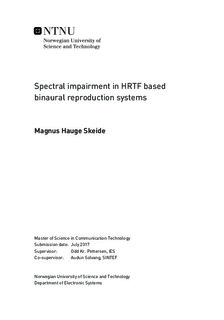Spectral impairment in HRTF based binaural reproduction systems
Master thesis
Permanent lenke
http://hdl.handle.net/11250/2467025Utgivelsesdato
2017Metadata
Vis full innførselSamlinger
Sammendrag
Higher Order Ambisonics is a method for capturing and reproducing sound fields. With Ambisonics` advantageous features and possibilities for binaural reproduction, the method has been established as one of the best ways of recreating 3D sound fields, and is widely used in both VR- and 360$^{\circ}$ applications. A drawback is that accurate reconstruction is only feasible inside a sphere, with radius $r$ limited by $ekr<2N-1$, where $e$ is the base of the natural logarithm, $k$ is the wavenumber and $N$ is the Ambisonics order.
This thesis presents the theory for spherical harmonics, binaural hearing and Ambisonics, and how they can be combined. HRTF datasets with different resolutions have been investigated to see if a recommended resolution can be suggested. Localization cues were also investigated. All evaluations were done with $\phi=0^{\circ}$ and for orders N=1-4.
For the HRTF reconstruction, the results behaved as expected. The lowest resolution dataset resembled its reference most for N=1-2. All of the datasets did sufficiently reconstruct the $ITD_p$ correctly for N=1-2. The key features of the $ILD$ were kept somewhat intact up to $f\approx6$kHz, with some ambiguity.
The results are based on a visual comparison model. The work in this thesis lacks a more clear, objective measure, and should also be complimented with a listening test showing the significance of the changes. Hence, this thesis does not present a strong enough foundation to provide a conclusion for a recommended HRTF resolution. However, ideas for future work are presented, which could be implemented in order to reach the desired conclusion.
